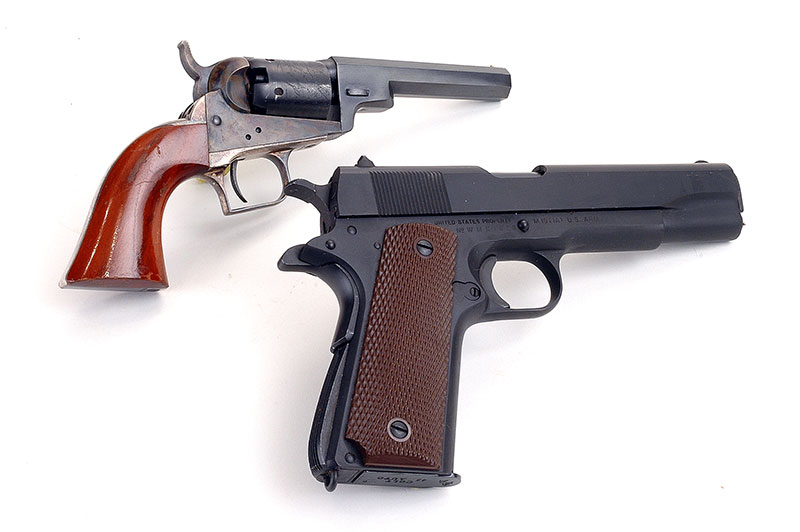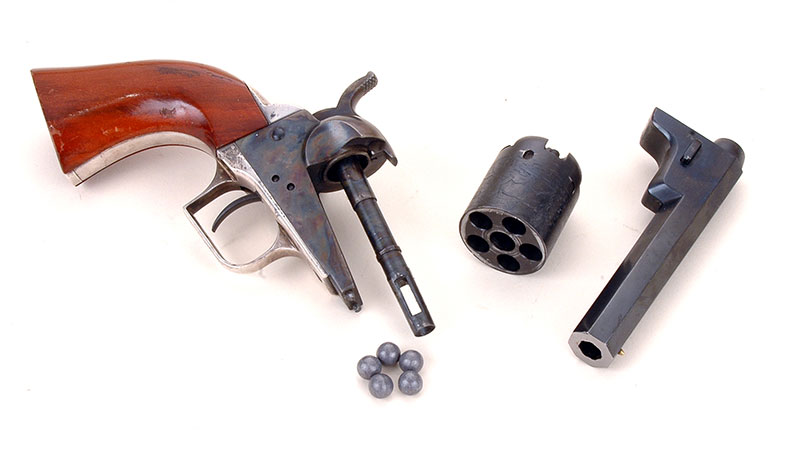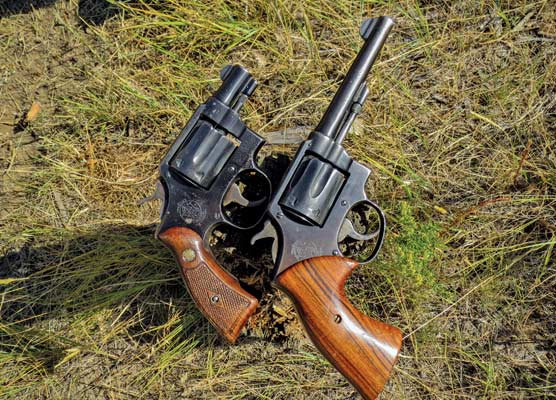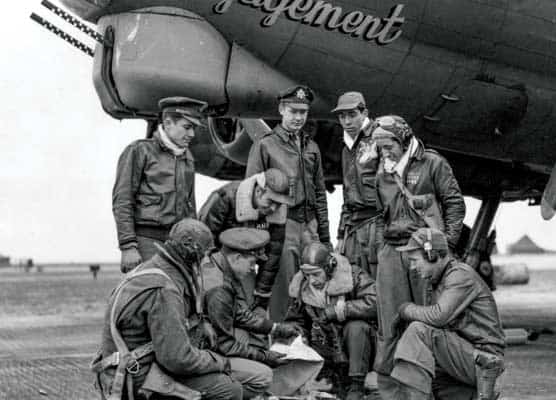The Babies
Part 3 of 12 Part Genesis of the Colt Single Action
As early as 1848 Samuel Colt realized the military market was going to be finite. After all, the U.S. Army was a relatively small organization and those troops issued handguns were an even smaller part of it. But there were millions of Americans with money in their pockets, in an era when it was generally accepted that men in many areas needed to go armed. All were potential buyers of Colt revolvers.
Furthermore, not all of them traveled with horses to help bear the weight of huge handguns. By the late 1840s steamboat and stagecoach travel was common. So were highwaymen and bandits of all types. While openly carrying a handgun in most sparsely settled American locales wasn’t frowned on, still it was considered a bit less dignified to have one’s weapons on display.
Cognizant of this, as early as 1848 Samuel Colt developed what collectors have termed the Baby Dragoon. Even by today’s standards it would be considered a small handgun. Barrel lengths were three, four, five and six inches and weight a mere 22 ounces with 4″ barrel. Most Baby Dragoons had no rammer beneath the barrel but according to some collectors’ sources a few were made with them. A weight saving factor was that this little revolver was only a five-shooter. That allowed cylinder diameter to be a mere 1.25″.
Caliber for the Baby Dragoon was .31. As detailed in previous segments, in the early days of Colt single action revolvers caliber was determined by the bore diameter of the barrel. Factor in rifling groove depth and these little guns were actually a bit over .32 caliber.
Regardless, they certainly weren’t heavy hitters. A .325″ pure lead round ball weighs just 48 grains, and the chambers of a Baby Dragoon’s cylinder (2nd Generation Colt production) will hold a mere 13 grains of Goex FFFg black powder. That charge will propel the 48-grain ball to only 695 fps according to my chronograph.
How Much Go?
Once in an effort to see just how much punch a .31 caliber Baby Dragoon gave, I fired it into a baffle box of 7/8″ soft pine boards. The ball lodged in the 3rd board. That doesn’t sound like much but the U.S. Army’s Ordnance Department in the late 1800s felt that 1″ of penetration in soft pine equaled a potentially fatal wound in humans. That said, however, it’s a safe bet traveling gentlemen also felt a good fighting knife was a worthy companion to a .31 caliber Baby Dragoon revolver.
That was especially true when one considers a “speed reload” with a rammer-less Baby Dragoon probably took about 10 minutes. And just how was a rammer-less Baby Dragoon loaded? First it had to be disassembled into its three basic pieces: frame, cylinder and barrel. Then the powder charge was dispensed into the chamber and a round ball set on top. It was rammed home using the cupped end of the cylinder’s base pin, holding it by the grip frame as one pushed. After this was done to all five chambers the little gun was reassembled and only then was a percussion cap placed on each chamber’s nipple. The whole procedure was an onerous chore, made much less tedious if one considers that without such a chore self-defense devolved back to a knife.
How did people go about packing these little revolvers without shooting themselves? After all no one would want to carry a five-shooter with a chamber empty and hammer down on it: a technique that came to be recommended for Colt Peacemakers a few decades later. On Colt percussion revolvers there was a tiny nub between each chamber’s nipple and a corresponding groove in the hammer for it to fit into. That was supposed to keep the hammer from contacting the percussion cap next to it.
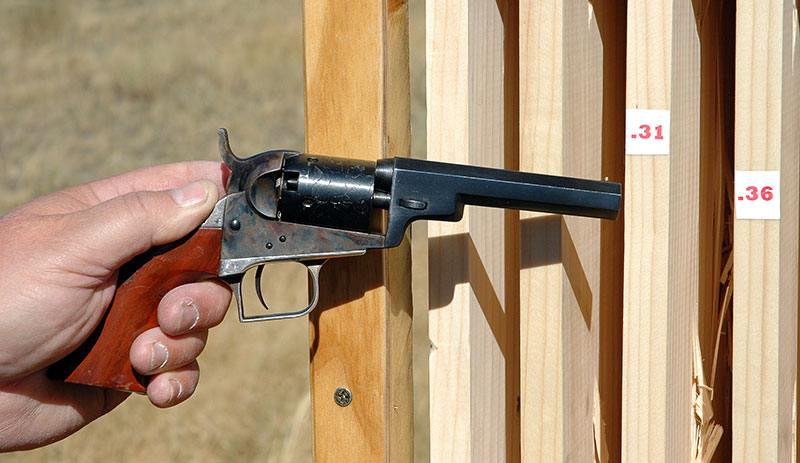
Duke fired his 2nd Generation Colt Baby Dragoon .31’s 48-grain round ball moving at a muzzle
velocity of 700 fps into this wooden baffle box. It fully penetrated two 7/8" soft pine boards and lodged in the third.
The U.S. Army Ordnance Board of that era equated penetration of 1" of soft pine as a potentially fatal wound.
Very Few
Therefore, it’s no wonder only about 15,000 Baby Dragoons were produced before Samuel Colt decided a remodeling was in order. That led to the most prolific of all Colt percussion revolvers: the Model 1849. Like the Baby Dragoon it was .31 caliber and barrel lengths of three, four, five and six inches were options. Unlike the earlier .31 most Model 1849s came with rammer beneath the barrel, and there was one other interesting option. That is that Model 1849s could be had in either five-shooter or six-shooter versions.
Somewhere along the way, Samuel Colt must have decided brass grip frames just didn’t have a quality enough look. So with the little .31s grip frames were still cut from brass but then they were silver-plated. Also, it’s worth noting the Baby Dragoon had a square back trigger guard but the Model 1849’s was round. For some strange reason when Colt decided to offer virtually all of their percussion revolvers again in the 1970s and 1980s they ignored the Model 1849 totally and made only about 1,500 of the Baby Dragoons.
That is completely converse from the sales history of the original Model 1849s. Of all cap and ball Colt revolvers produced between 1847 and 1873, the Model 1849 .31 caliber wins the prize for most made. Over 325,000 were manufactured in America between 1850 and 1873, which is far more than any other single Colt percussion model. Is that a hint as to who was doing the most handgun buying in those days. Was it the hard, leather skinned, frontiersman or the well-dressed traveling businessman in more civilized areas? And get this; in 1853 Samuel Colt set up a factory in London, England (of all places) and produced about another 11,000 more Model 1849s over there.
At this point, about 1850, Sam Colt has the military fairly well covered in regards to sidearms and is going great-guns in getting the more gentle side of American life set for self-defense. So what is he missing? The adventuresome: those who are going to follow the great gold strikes and the general westward migration.
Next comes the “Belt Pistols” and with them the myth of the gunfighter.
Click Here To View List And Links To All Colt Series Articles

